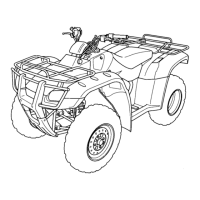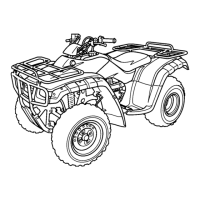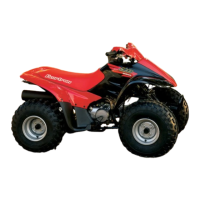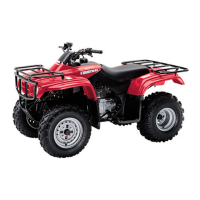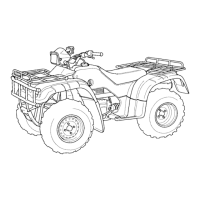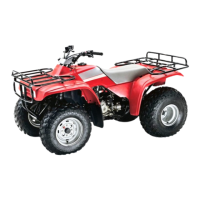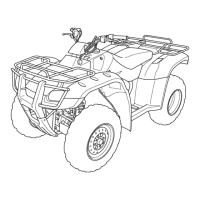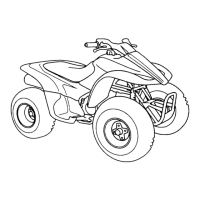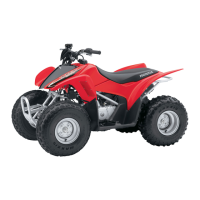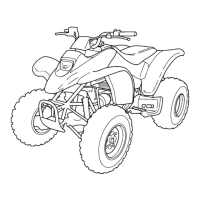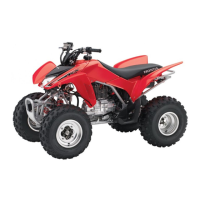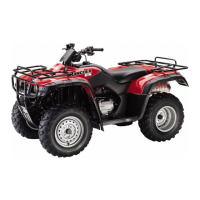
Do you have a question about the Honda 2000 TRX350TE FourTrax 350 ES and is the answer not in the manual?
| Brand | Honda |
|---|---|
| Model | 2000 TRX350TE FourTrax 350 ES |
| Category | Offroad Vehicle |
| Language | English |
Emphasizes the importance of reading the manual for safety, operation, and maintenance.
States the minimum age for operating the vehicle and warns against underage operation.
Recommends certified rider training for safe operation and provides a contact number.
Explains safety messages and symbols, including danger and warning indicators.
Expresses gratitude for purchasing and highlights Honda's ATV leadership.
Advises on break-in procedures for optimal vehicle performance.
Recommends using genuine Honda parts for replacement and accessories.
Mentions the availability of a Maintenance Schedule and Honda Service Manual.
Outlines critical safety warnings for ATV operation, including injury risks.
Details the importance and placement of vehicle safety labels.
Explains emission control standards applicable to the vehicle.
Provides a schedule for regular maintenance items and intervals.
Lists safety precautions to follow before performing maintenance.
Details the contents of the provided tool kit for basic repairs.
Covers refueling, fuel gauge, and fuel valve procedures.
Advises on the type of fuel and octane rating to use.
Explains the use and effects of oxygenated fuels like ethanol and methanol.
Covers throttle cable and lever checks and adjustments.
Details cleaning and replacement procedures for the air cleaner.
Explains how to clean the air cleaner housing drain tube.
Covers carburetor adjustments, including idle speed and altitude.
Provides recommendations for engine oil and oil filter changes.
Details the procedure for changing the rear final gear case oil.
Explains how to check and replace the spark plug.
Mentions valve clearance and adjustment procedures.
Details how to adjust the clutch for proper operation.
Covers battery location, maintenance, and removal procedures.
Explains the location and replacement of fuses.
Covers front and rear brake checks, adjustments, and fluid levels.
Details wheel removal, installation, and tire maintenance.
Outlines the procedure for removing and reinstalling the seat.
Explains the function and inspection of engine guards and skid plates.
Details the procedure for purging the exhaust system's spark arrester.
Provides instructions and precautions for transporting the ATV.
Covers procedures and precautions for cleaning the ATV.
Outlines steps for properly storing the ATV for extended periods.
Identifies key controls on the handlebars, such as brake levers and switches.
Explains indicators and the multi-function display on the dashboard.
Identifies external parts on the right and left sides of the ATV.
Describes the function and positions of the ignition switch for starting the engine.
Explains the operation of the engine stop switch for safety control.
Details the location and use of the choke knob for cold engine starting.
Identifies the starter button and headlight switches on the handlebars.
Explains the function of the starting primer knob for cold weather starting.
Describes the procedure for operating the recoil starter.
Explains how to operate the throttle lever for acceleration.
Details the operation of headlight and dimmer switches for illumination.
Explains the reverse, neutral, and oil high temperature indicators.
Describes the functions of the gear position, speedometer, odometer, and clock.
Explains the upshift and downshift switches for gear changes.
Details how to operate the reverse selector knob for shifting into reverse.
Describes the operation of front and rear brakes, including parking brake.
Explains the fuel gauge, fuel fill cap, and fuel valve operations.
Describes features like helmet holder and flag pole bracket.
Explains the use and location of the helmet holder.
Details the location and purpose of the flag pole bracket.
Explains the location and use of the trailer hitch.
Describes the storage compartment and its contents.
Explains the function and limitations of the accessory socket.
Details how to check and add engine oil using the dipstick.
Covers age recommendations and initial rider training for safe operation.
Outlines pre-ride inspection checks for safe operation.
Recommends certified rider training for safe operation.
Details essential rules for safe operation, including protective gear and speed control.
Specifies required protective gear for safe ATV riding.
Warns against carrying passengers as the ATV is designed for single riders.
Advises against operating the ATV under the influence of alcohol or drugs.
Clarifies that the ATV is designed for off-road use only.
Emphasizes keeping hands and feet on controls for balance and control.
Advises on controlling speed based on conditions and experience.
Warns against performing stunts like wheelies or jumps.
Covers careful operation on unfamiliar terrain and visibility.
Provides guidance on safely riding up and down hills.
Explains how to maintain balance and control when crossing slopes.
Advises on safely riding over obstacles like bumps and ruts.
Provides precautions for riding through water.
Details the correct procedure for parking the ATV safely.
Lists the physical dimensions and weight specifications of the ATV.
Details fluid capacities like engine oil and fuel tank.
Provides details on bore, stroke, displacement, and spark plug.
Lists specifications for caster angle, trail length, and tire size.
Details gear ratios, battery, generator, and lighting specifications.
Lists the ratings for main and sub fuses.
Explains source of emissions and control systems used on the ATV.
Details the ATV's exhaust emission control system.
Explains the crankcase emission control system.
Details regulations and tampering prohibitions for noise emissions.
Lists symptoms that may affect ATV emissions and require dealer inspection.
